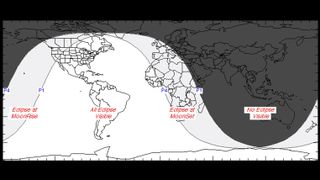
Lunar eclipses occur when Earth’s shadow blocks the sun’s light, which otherwise reflects off the moon. There are three types — total, partial and penumbral — with the most dramatic being a total lunar eclipse, in which Earth’s shadow completely covers the moon. The next lunar eclipse will be a penumbral lunar eclipse on Jan. 10, 2020 and will be visible from Europe, Africa, Asia and Australia.
Throughout history, eclipses have inspired awe and even fear, especially when total lunar eclipses turned the moon blood-red, an effect that terrified people who had no understanding of what causes an eclipse and therefore blamed the events on this god or that. Below, you’ll find the science and history of lunar eclipses, learn how they work, and see a list of the next ones on tap.
The last lunar eclipse was on July 16, 2019. It was a partial lunar eclipse. Here is a schedule of lunar eclipse coming in 2020:
- Jan. 10: Penumbral eclipse. Visible from parts of North America, Europe, Africa, Asia and Australia.
- June 5: Penumbral eclipse. Visible from parts of South America, Europe, Africa, most of Asia and Australia.
- July 5: Penumbral eclipse. Visible from most of North America, South America, western Europe and Africa.
- Nov. 30: Penumbral eclipse. Visible from North America, South America, northern Europe, eastern Asia and Australia.
-

(Image credit: Fred Espenak/NASA) Penumbral Lunar Eclipse of June 5, 2020

(Image credit: Fred Espenak/NASA) Penumbral Lunar Eclipse of July 5, 2020

(Image credit: Fred Espenak/NASA) Penumbral Lunar Eclipse of Nov. 30, 2020
The next total lunar eclipse, or “blood moon,” won’t occur until May 26, 2021, and it will be visible from eastern Asia, Australia, the Pacific Ocean and much of the Americas. A partial lunar eclipse will follow on Nov. 19, 2021, and it will be visible from North and South America, Australia, and parts of Europe and Asia. Those will be the only two lunar eclipses in 2021.
NASA keeps a list predicting lunar eclipses until 2100. They also keep data about past lunar eclipses. During the 21st century, Earth will experience a total of 228 lunar eclipses, according to the space agency.




















































































